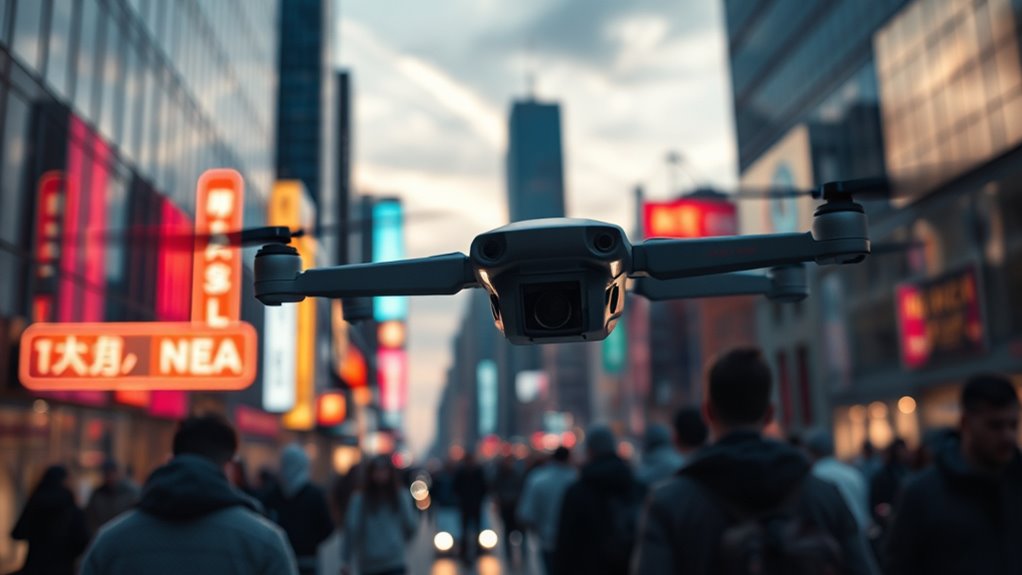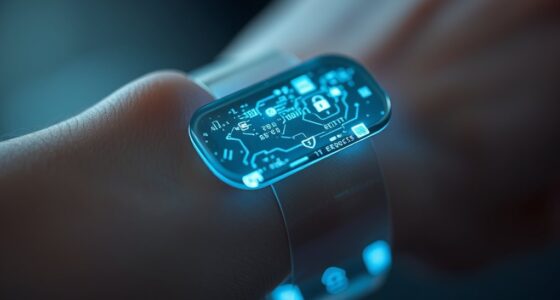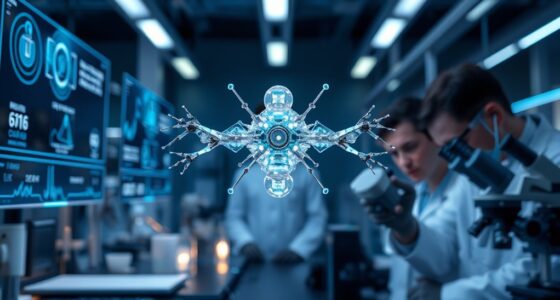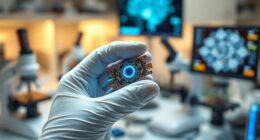Nano-surveillance devices can gather vast amounts of personal data covertly, raising serious privacy concerns. They often operate without your knowledge or explicit consent, making it hard to control what information is collected or shared. Encryption helps protect your data, but it isn’t enough alone. To understand how to safeguard yourself and stay informed about these emerging risks, keep exploring the important challenges posed by nano-surveillance and how you can respond.
Key Takeaways
- Nano-surveillance devices can collect vast personal data covertly, raising significant privacy concerns.
- Data encryption is vital to protect sensitive information but isn’t sufficient alone to ensure privacy.
- Lack of user consent and transparency in nano-surveillance undermines individual autonomy and legal rights.
- Increased risks of hacking and data misuse threaten personal security and privacy integrity.
- Ongoing vigilance, regulation, and advocacy are essential to address evolving privacy challenges in nano-surveillance.
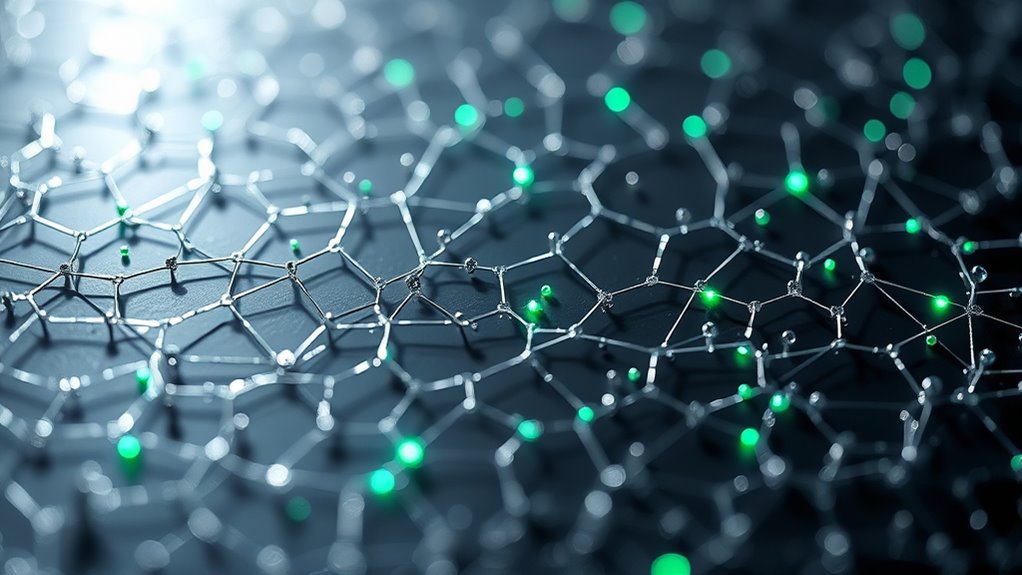
As nano-surveillance technology advances, it brings with it unprecedented privacy concerns that are difficult to ignore. These tiny sensors and devices can gather vast amounts of personal data, often without your knowledge. The challenge lies in protecting this sensitive information from misuse or unauthorized access. Data encryption becomes an essential tool in this landscape. It’s what keeps your data safe by transforming it into an unreadable format, ensuring that even if intercepted, it can’t be deciphered by malicious actors. But encryption alone isn’t enough. You also need to be aware of how your data is being collected and used. That’s where user consent comes into play. As a user, you should have control over what information you share and how it’s handled. Unfortunately, with nano-surveillance, consent can often be bypassed or obscured. These devices can operate covertly, making it difficult for you to understand when data is being collected or to give informed approval. This lack of transparency raises serious questions about individual autonomy and rights. You might find yourself in a situation where your personal information is being captured without your explicit awareness, raising ethical and legal concerns. To address this, regulations must emphasize clear, accessible consent protocols. Companies and developers should prioritize transparency, ensuring you are fully informed about what data is being gathered and for what purpose. They should also implement robust data encryption methods to protect your information in transit and storage. Without proper safeguards, your personal details could be vulnerable to hacking, identity theft, or surveillance abuses. The risk isn’t just theoretical; as nano-surveillance becomes more pervasive, the potential for intrusive monitoring grows. This means your privacy could be compromised on a much larger scale, affecting your freedom and sense of security. You need to be proactive, demanding that organizations uphold strict standards for data encryption and user consent. Only then can you maintain some control over your personal space in this increasingly interconnected world. As technology evolves, staying informed about how your data is protected and how your consent is obtained becomes essential. Remember, safeguarding your privacy isn’t solely about trusting technology but also about ensuring transparent practices that respect your rights. Moreover, understanding the legal aspects involved can help you better advocate for your privacy rights. Ultimately, balancing innovation with privacy rights will require ongoing vigilance and advocacy on your part. Only through diligent oversight and clear policies can you truly protect yourself against the privacy challenges posed by nano-surveillance.
Frequently Asked Questions
How Can Nano-Surveillance Be Regulated Effectively?
You can regulate nano-surveillance effectively by establishing clear ethical frameworks and adopting international regulations. Engage policymakers, technologists, and ethicists to create guidelines that prioritize privacy and human rights. Enforce strict compliance measures, and promote transparency in how nano-surveillance tools are used. Regularly update regulations to keep pace with technological advancements, ensuring consistent protection across borders and preventing misuse or abuse of nano-surveillance technologies.
What Are the Long-Term Health Effects of Nano-Devices?
Imagine tiny spies inside your body, quietly working away. You might wonder about their long-term health effects. You should know that biocompatibility concerns and bioaccumulation risks pose real dangers, potentially causing inflammation or toxicity over time. Ongoing research aims to understand these impacts, but you’re advised to stay cautious. Continuous monitoring and regulation are essential to ensure nano-devices don’t harm your health in the future.
Who Has Access to Nano-Surveillance Data?
You might wonder who has access to nano-surveillance data. Usually, data ownership determines who controls it, often limited to authorized entities like government agencies or private companies. Access control measures are put in place to guarantee only those with proper permissions can view or use the data. Be aware that without strict controls, unauthorized individuals could gain access, raising significant privacy concerns.
Can Nano-Sensors Be Hacked or Manipulated?
Yes, nano-sensors can be hacked or manipulated. Nano hack vulnerabilities exist because these tiny devices often have limited security measures, making them susceptible to cyber attacks. Sensor manipulation is also possible if bad actors find ways to interfere with their functioning, either through direct tampering or exploiting software weaknesses. You should be aware of these risks, especially if you rely on nano-sensors for critical data or decision-making.
How Do Privacy Laws Adapt to Nano-Technology Advancements?
You’ll find that privacy laws are evolving slowly, with only 30% of countries updating regulations to cover nano-privacy concerns. As nano-technology advances, legal adaptation becomes essential to protect individual rights. Governments are starting to craft specific laws addressing nano-sensors and data collection, but it’s a race against rapid innovation. Staying informed and advocating for thorough regulations will help guarantee your privacy remains protected in this tiny tech world.
Conclusion
As you navigate the world of nano-surveillance, remember that each tiny device is like a double-edged sword—a beacon of progress, yet a shadow of intrusion. The nano-needle, symbolizing precision, can both heal and harm. Protecting your privacy is like guarding a delicate flame—once extinguished, it’s hard to reignite. Stay vigilant, for in this microscopic domain, your personal boundaries are the lantern guiding you through the darkness of unchecked surveillance.
